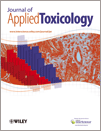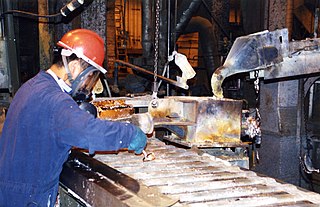Related Research Articles
In toxicology, the median lethal dose, LD50 (abbreviation for "lethal dose, 50%"), LC50 (lethal concentration, 50%) or LCt50 is a measure of the lethal dose of a toxin, radiation, or pathogen. The value of LD50 for a substance is the dose required to kill half the members of a tested population after a specified test duration. LD50 figures are frequently used as a general indicator of a substance's acute toxicity. A lower LD50 is indicative of increased toxicity.

Tracheal intubation, usually simply referred to as intubation, is the placement of a flexible plastic tube into the trachea (windpipe) to maintain an open airway or to serve as a conduit through which to administer certain drugs. It is frequently performed in critically injured, ill, or anesthetized patients to facilitate ventilation of the lungs, including mechanical ventilation, and to prevent the possibility of asphyxiation or airway obstruction.

Toxicity is the degree to which a chemical substance or a particular mixture of substances can damage an organism. Toxicity can refer to the effect on a whole organism, such as an animal, bacterium, or plant, as well as the effect on a substructure of the organism, such as a cell (cytotoxicity) or an organ such as the liver (hepatotoxicity). By extension, the word may be metaphorically used to describe toxic effects on larger and more complex groups, such as the family unit or society at large. Sometimes the word is more or less synonymous with poisoning in everyday usage.

A route of administration in pharmacology and toxicology is the path by which a drug, fluid, poison, or other substance is taken into the body.
In toxicology, the lethal dose (LD) is an indication of the lethal toxicity of a given substance or type of radiation. Because resistance varies from one individual to another, the "lethal dose" represents a dose at which a given percentage of subjects will die. The lethal concentration is a lethal dose measurement used for gases or particulates. The LD may be based on the standard person concept, a theoretical individual that has perfectly "normal" characteristics, and thus not apply to all sub-populations.

Ethion (C9H22O4P2S4) is an organophosphate insecticide. Ethion is known to affect a neural enzyme called acetylcholinesterase and prevent it from working.

1,4-Dioxane is a heterocyclic organic compound, classified as an ether. It is a colorless liquid with a faint sweet odor similar to that of diethyl ether. The compound is often called simply dioxane because the other dioxane isomers are rarely encountered.

Sawdust is a by-product or waste product of woodworking operations such as sawing, sanding, milling, planing, and routing. It is composed of small chippings of wood. These operations can be performed by woodworking machinery, portable power tools or by use of hand tools. Wood dust is also the byproduct of certain animals, birds and insects which live in wood, such as the woodpecker and carpenter ant. In some manufacturing industries it can be a significant fire hazard and source of occupational dust exposure.
Nanotoxicology is the study of the toxicity of nanomaterials. Because of quantum size effects and large surface area to volume ratio, nanomaterials have unique properties compared with their larger counterparts that affect their toxicity. Of the possible hazards, inhalation exposure appears to present the most concern, with animal studies showing pulmonary effects such as inflammation, fibrosis, and carcinogenicity for some nanomaterials. Skin contact and ingestion exposure are also a concern.

Benzotrichloride (BTC), also known as α,α,α-trichlorotoluene, phenyl chloroform or (trichloromethyl)benzene, is an organic compound with the formula C6H5CCl3. Benzotrichloride is an unstable, colorless (to yellowish), viscous, chlorinated hydrocarbon with a penetrating odor. Benzotrichloride is used extensively as a chemical intermediate for products of various classes, i.e. dyes and antimicrobial agents.

The Journal of Applied Toxicology is a monthly peer-reviewed scientific journal published since 1981 by John Wiley & Sons. It covers all aspects of toxicology and publishes reviews and research articles on mechanistic, fundamental, and applied research relating to the toxicity of drugs and chemicals at the molecular, cellular, tissue, target organ, and whole body level, both in vivo and in vitro/ex vivo.
Ultrafine particles (UFPs) are particulate matter of nanoscale size (less than 0.1 μm or 100 nm in diameter). Regulations do not exist for this size class of ambient air pollution particles, which are far smaller than the regulated PM10 and PM2.5 particle classes and are believed to have several more aggressive health implications than those classes of larger particulates. In the EU UFP's in ambient air are empirically defined by a technical specification. The important detail is the definition of size, stated: "The lower and upper sizes considered within this document are 7 nm and a few micrometres, respectively". Although the most common referral to UFP is "less than 0.1μm", this is incorrect for ambient air in the EU.

Hexachlorocyclopentadiene (HCCPD), also known as C-56, Graphlox, and HRS 1655, is an organochlorine compound with the formula C5Cl6. It is a precursor to pesticides, flame retardants, and dyes. It is a colourless liquid although commercial samples appear lemon-yellow liquid sometimes with a bluish vapour. Many of its derivatives proved to be highly controversial, as studies showed them to be persistent organic pollutants. An estimated 270,000 tons were produced until 1976. Two prominent manufacturers were Velsicol Chemical Corporation in the US and by Jiangsu Anpon Electrochemicals Co. in China.
Acute inhalation injury may result from frequent and widespread use of household cleaning agents and industrial gases. The airways and lungs receive continuous first-pass exposure to non-toxic and irritant or toxic gases via inhalation. Irritant gases are those that, on inhalation, dissolve in the water of the respiratory tract mucosa and provoke an inflammatory response, usually from the release of acidic or alkaline radicals. Smoke, chlorine, phosgene, sulfur dioxide, hydrogen chloride, hydrogen sulfide, nitrogen dioxide, ozone, and ammonia are common irritants.

Occupational toxicology is the application of the principles and methodology of toxicology to understanding and managing chemical and biological hazards encountered at work. The objective of the occupational toxicologist is to prevent adverse health effects in workers that arise from exposures in their work environment.
There has been much research on the nanotoxicology of fullerenes and carbon nanotubes.

Pharyngeal aspiration is the introduction of a substance into the pharynx and its subsequent aspiration into the lungs. It is used to test the respiratory toxicity of a substance in animal testing. It began to be used in the late 1990s. Pharyngeal aspiration is widely used to study the toxicity of a wide variety of substances, including nanomaterials such as carbon nanotubes.
The health and safety hazards of nanomaterials include the potential toxicity of various types of nanomaterials, as well as fire and dust explosion hazards. Because nanotechnology is a recent development, the health and safety effects of exposures to nanomaterials, and what levels of exposure may be acceptable, are subjects of ongoing research. Of the possible hazards, inhalation exposure appears to present the most concern, with animal studies showing pulmonary effects such as inflammation, fibrosis, and carcinogenicity for some nanomaterials. Skin contact and ingestion exposure, and dust explosion hazards, are also a concern.
Hazard substitution is a hazard control strategy in which a material or process is replaced with another that is less hazardous. Substitution is the second most effective of the five members of the hierarchy of hazard controls in protecting workers, after elimination. Substitution and elimination are most effective early in the design process, when they may be inexpensive and simple to implement, while for an existing process they may require major changes in equipment and procedures. The concept of prevention through design emphasizes integrating the more effective control methods such as elimination and substitution early in the design phase.

Titanium dioxide nanoparticles, also called ultrafine titanium dioxide or nanocrystalline titanium dioxide or microcrystalline titanium dioxide, are particles of titanium dioxide (TiO2) with diameters less than 100 nm. Ultrafine TiO2 is used in sunscreens due to its ability to block UV radiation while remaining transparent on the skin. It is in rutile crystal structure and coated with silica or/and alumina to prevent photocatalytic phenomena. The health risks of ultrafine TiO2 from dermal exposure on intact skin are considered extremely low, and it is considered safer than other substances used for UV protection.
References
- 1 2 3 4 5 Driscoll, Kevin E.; Costa, Daniel L.; Hatch, Gary; Henderson, Rogene; Oberdorster, Gunter; Salem, Harry; Schlesinger, Richard B. (2000-05-01). "Intratracheal Instillation as an Exposure Technique for the Evaluation of Respiratory Tract Toxicity: Uses and Limitations". Toxicological Sciences. 55 (1): 24–35. doi: 10.1093/toxsci/55.1.24 . ISSN 1096-6080. PMID 10788556.
- ↑ "CALS Manual: Endotracheal Drug Delivery". Comprehensive Advanced Life Support Rural Emergency Medical Education. 2011-10-13. Retrieved 2017-02-20.
- 1 2 "Occupational Exposure to Refractory Ceramic Fibers". U.S. National Institute for Occupational Safety and Health . May 2006. pp. 38–39, 42, 89. Retrieved 2017-02-17.
- ↑ Rao, G. V. S.; Tinkle, Sally; Weissman, David; Antonini, James; Kashon, Michael; Salmen, Rebecca; Battelli, Lori; Willard, Patsy; Hubbs, Ann (2003-01-01). "Efficacy of a Technique for Exposing the Mouse Lung to Particles Aspirated from the Pharynx". Journal of Toxicology and Environmental Health, Part A. 66 (15–16): 1441–1452. doi:10.1080/15287390306417. ISSN 1528-7394. PMID 12857634. S2CID 38171132 . Retrieved 2017-03-01.
- 1 2 "Occupational Exposure to Carbon Nanotubes and Nanofibers". U.S. National Institute for Occupational Safety and Health. April 2013. pp. 15–17, 48. Retrieved 2017-02-17.
- ↑ Zhao, Yuliang (2016-12-12). Toxicology of Nanomaterials. John Wiley & Sons. p. 163. ISBN 9783527337972.
- ↑ Schiller, Erich (2013-06-29). Free Radicals and Inhalation Pathology. Springer Science & Business Media. p. 63. ISBN 9783642186196.